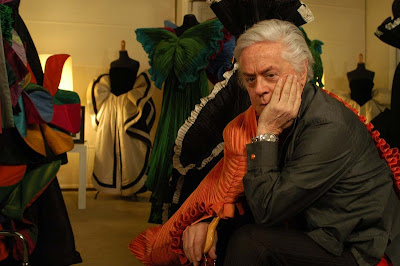 |
| Roberto with his gowns |
“Nothing more than stark, elegant
shapes with hems cropped daringly short – designed to make women look
outrageously young yet mondaine.” – Vogue 1961
“Roberto Capucci: Art Into Fashion.” Those three last words describes exactly what Roberto Capucci is all about and by having that title next to his name, I was drawn to his designs.
His creations are more then just fashion; they’re also pieces of art. Most gowns only reach their full potential beauty once they are put on someone to wear but it is not the case for Capucci’s gowns. Even on mannequins, his gowns are breathtaking and no matter what, extraordinary.
He was born in beautiful Rome, Italy
in the 1930s. He went off to study at Rome’s Accademia di Belle Arti. Before he
planned on opening his own fashion house, Roberto had his first job working for
designer, Emilio Schuberth.
 “Nature
is my mentor. In my garden, quietly watching with a childlike sense of fantasy,
has helped to instill in me a sense of balance and constant search of
perfection, proportion, harmony.” - Capucci on inspiration
“Nature
is my mentor. In my garden, quietly watching with a childlike sense of fantasy,
has helped to instill in me a sense of balance and constant search of
perfection, proportion, harmony.” - Capucci on inspiration
 |
| Young Roberto in studio |
At the age of 20, a Florence
businessman, who had planned on featuring five of Capucci’s gowns, put on a
fashion show. He was never featured in the fashion show after all since the
other couturiers felt up-staged by his gowns. Fortunately, the press got a word
of this and insisted on seeing Roberto’s designs, which then sold immediately.
His career couldn’t have taken off at
a better time. He was presented right in the midmost of the rise of the Italian
fashion industry and of Italian high fashions, following World War II.
At 21 years old, Roberto Capucci had
opened his first fashion house in Rome. In 1962, Roberto moved to Paris. He
opens his own couture salon on Rue Cambon and it is in Paris where he starts to
get more experimental with his designs; making them more colorful, more playful
and with the use of unusual materials such as, plastic and stones.
 |
| Sculpture Dress, 1992, silk satin |
 |
| Sculpture Dress, 1984, silk crepe and silk gazar |
By 1968, he retired to his main salon
at the via Gregorina in Rome, where he re-established himself and continued his
work as a courtier and artist.
 |
| Bows He retired from the daily running of his house in the 1980. Instead, he created a collection a year for a different city each year and would display his collection in museums. (1982 to 1996) His Inspiration |
 “Nature
is my mentor. In my garden, quietly watching with a childlike sense of fantasy,
has helped to instill in me a sense of balance and constant search of
perfection, proportion, harmony.” - Capucci on inspiration
“Nature
is my mentor. In my garden, quietly watching with a childlike sense of fantasy,
has helped to instill in me a sense of balance and constant search of
perfection, proportion, harmony.” - Capucci on inspiration
Being
inspired by architecture and nature, he calls his work, “A study in form.”
Roberto Capucci had the ability to
make his designs stand out, no matter what the current trends were. He is known
for his very courageous experiments with fashion. His gowns are at the most
basic level, sculptors made out of fabric and yet, there is nothing basic about
a Roberto Capucci gown. The geometric lines found in his designs follow the
opposite shape of a women’s body, exaggerating it to the maximum.
“I
come from an artistic background and have always seen dresses as a way t0 express myself rather then to create fashion.” - Roberto Capucci
The
business of fashion never appealed to Roberto and he hated the publicity that
came with it. He held his fashion shows in silence and would refuse to
duplicate his gowns for his customers. In order to purchase a Roberto Capucci
gown, customers had to fit into his models’ runway dresses.
Then
again, his designs were for very particular women in mind.
“He designed for an
abstract woman, the women you can never meet. His extravagance meant the wearer
becomes secondary to the gown." - Alison Adburgham on Capucci's creations
He
collaborated with other designers such as Valentino, Balenciaga, Yves St. Laurent
and Oscar de la Renta and is deeply respected by contemporary designers for his
avant-garde silhouettes and amazing use of color and materials.






















0 comments:
Post a Comment